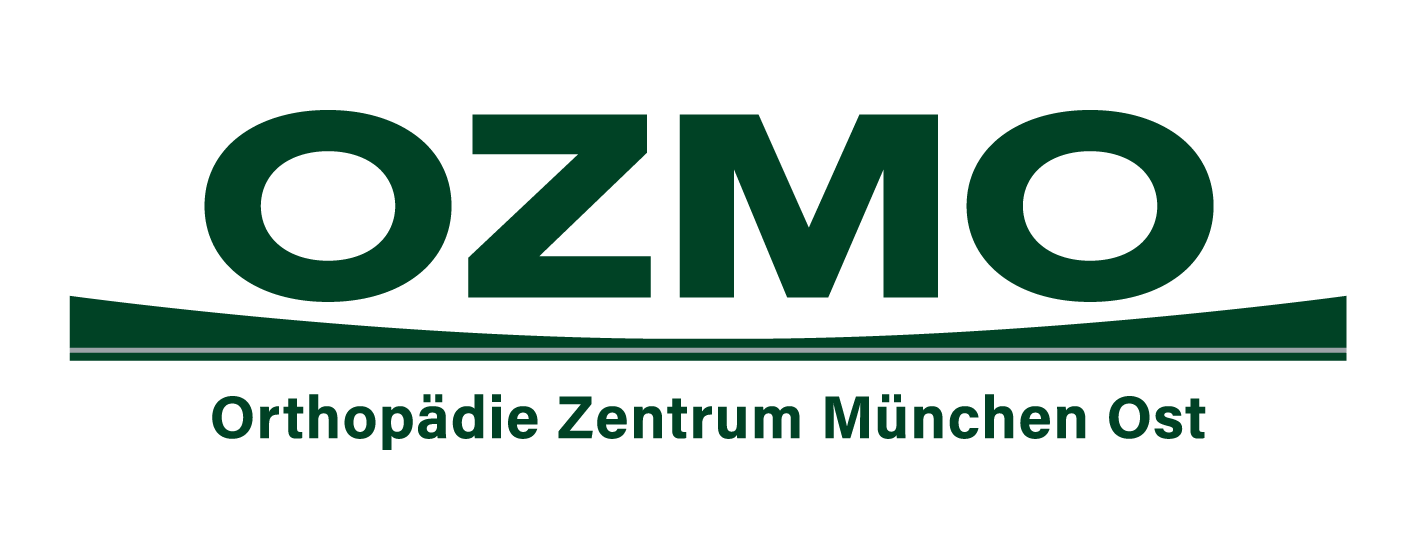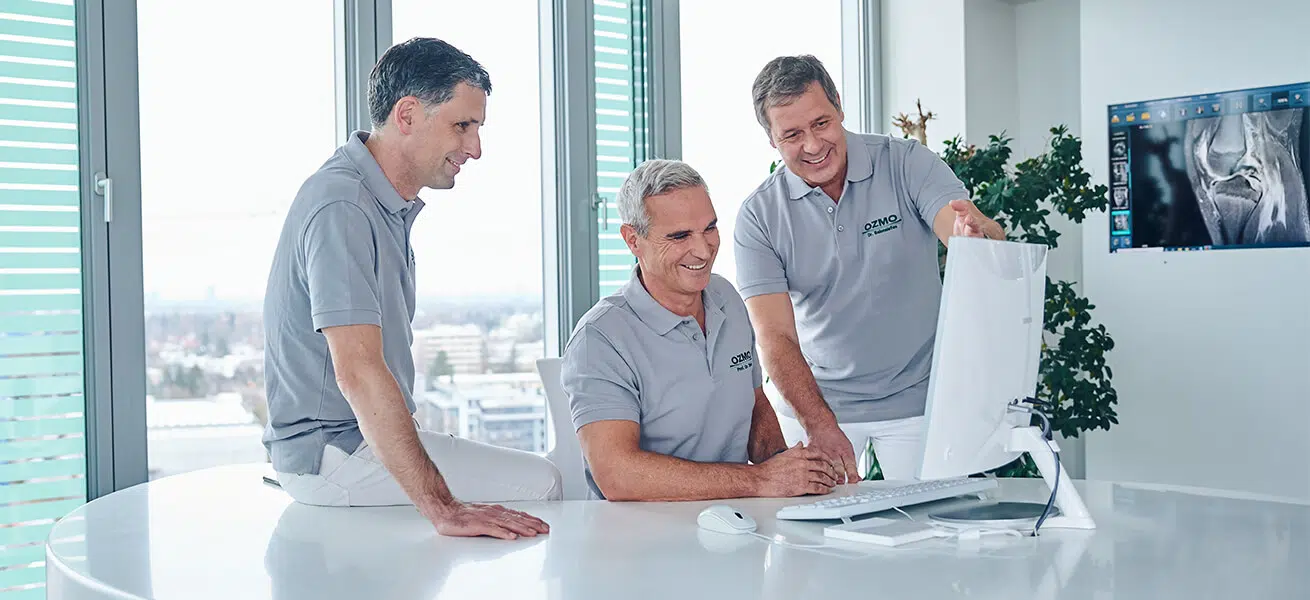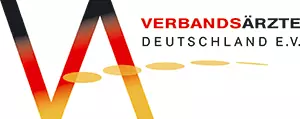Glossary
Orthopedic knowledge from A-Z
A
Achillodynia
Pain syndrome of the Achilles tendon, the attachment of the calf muscles to the heel bone.
Acupuncture
Medical history
Summary of a patient’s history of suffering.
Anulus fibrosos
See fibrocartilage ring
Application of focused sound waves
Application of high-frequency, focused shock waves to treat orthopedic conditions.
Arthrodesis
Surgical joint fusion
Arthroplasty
Surgical procedure designed to secure or restore joint function.
Osteoarthritis
Joint wear due to excessive load
Arthroscopy
Autologous cells
autologous cells (donor and recipient are the same person)
B
Disc prosthesis
Inserted between the vertebral bodies after a degenerated disc has been removed. The disc prosthesis is designed to maintain disc height as well as facilitate movement.
Intervertebral disc prosthetics
Chronic back pain caused by degeneration of the intervertebral disc is often treated with implantation of a disc prosthesis.
Disc Protrusion
Intervertebral disc curvature
Herniated disc
C
Chiropractic
Deals with disorders of the function of the musculoskeletal system, especially the spine. The hand is the only treatment tool of the chirotherapist in diagnostics and therapy.
Surgery
Chondrocytes
Cartilage cells
Chronic polyarthritis
Most common inflammatory disease of the joints in which they swell and become overheated. The disease usually progresses in episodes, whereby an episode and its symptoms can last between a few weeks and months.
Computed tomography
Imaging procedure in radiology using a computer.
CT (computed tomography)
Imaging procedure in radiology.
Cup prosthesis
Artificial surface replacement at the joint.
D
Thumb saddle joint
Saddle joint between the large polygonal bone and the first metacarpal bone.
Defect
Lat. for damage or error.
Degenerative
Indicates a deviation from the norm. This deviation may affect the shape and/or function of an organ.
Delta prosthesis
Form of prosthesis on the shoulder joint, which is used in cases of severe joint destruction in conjunction with large defects in the area of the muscular cuff of the shoulder.
Digital X-ray
Radiological procedures in which X-ray images are taken digitally.
Spinous process
Process of a vertebra.
Dynamic stabilization methods
E
Autologous blood / ACP therapy
Electrolyte solution
Solution in which salts are dissolved in the form of ions. Administered to compensate for water and electrolyte deficiencies, e.g. by infusion.
Elbow Osteoarthritis
Endoprosthetics
Endoscope
Device with which the interior of living organisms can be examined.
Occupational Therapy
Form of therapy that belongs to the medical healing professions. It helps people to (re)gain a capacity for action that has been lost or not yet existent due to illness, injury or disability. The goal is to achieve the greatest possible independence and autonomy in everyday life.
Erosion
Weeping, non-bleeding loss of substance of the skin or mucosa affecting only the epithelium.
Extremities
Limbs
F
Facet joint
(so-called vertebral arch joint) This refers to the two “small vertebral joints” that each vertebra of our spine has. They control the mobility between the individual vertebrae.
Facet infiltration
Targeted drug injection to gently eliminate the causes of pain in the area of the small vertebral joints with simultaneous anti-inflammatory effect.
Facet syndrome
Fibrocartilage ring
surrounds the soft intervertebral disc.
Heel spur
Bony spur on the calcaneus often caused due to overweight and pronation malalignment of the foot.
Fracture
Fracture of a bone.
G
Ganglion
ganglion; joint cyst
Joint surgery
includes surgical treatments of fresh or older injuries of all joints of the body as well as pathological changes of the joints due to wear and tear.
Joint lip
Fibrocartilaginous projection on the glenoid cavity to increase its surface area.
Acetabular cup
The counterpart to the rod end in a ball joint, which encloses it.
Synovial fluid
Clear body fluid in real joints that forms a lubricating film on the joint surfaces and thus contributes to shock absorption.
Joint gap
n gap-shaped cavity filled with synovial fluid between the cartilaginous surfaces of a joint.
H
Hallux rigidus
Hallux valgus
High frequency waves
High-frequency sound waves used in magnetic resonance imaging.
Hip arthroscopy
Reflection of the hip joint.
Hip prosthesis
Künstliches Hüftgelenk, dass durch eine Operation, als Folge von starkem Gelenkverschleiß, eingesetzt wird.
Humerus
Humerus
Hyaloronic acid injections
Alternative to autologous blood therapy for osteoarthritis. » Hyaloronic acid injection details
I
Impingement syndrome
Implantation
Insertion of replacement material into the body.
Infuse
Allowing a fluid to flow into the body by infusion.
Infusion therapy
refers to the continuous parenteral administration of fluids – such as drugs and electrolyte solutions – intravenously via a hypodermic needle over a specific period of time.
Hypodermic needle
Hollow needle used to penetrate human tissue to insert or withdraw fluids using a syringe.
Injection therapy
Instability of the spine
Two vertebral bodies shift against each other during movement.
Interventional radiology
Subfield of diagnostic radiology. Therapeutic interventions are performed under image guidance (ultrasound, CT, MRI, angiography).
Intravenous
“in a vein”, “into a vein”. Direct administration of a drug or fluid into a venous blood vessel.
Sciatic nerve
Most powerful nerve of the body in the lumbar-cruciate nerve plexus.
K
K-Taping
Calcareous shoulder
Cardiology
Study of the heart, dealing with its structures, functions in the organism and diseases of the heart.
Carpal tunnel syndrome
Magnetic resonance imaging
Small vertebral joints
(facet joints), Are aligned horizontally, vertically or obliquely depending on their function. They allow lateral inclination, rotation, flexion and extension of the back.
Compressed
Crowded, condensed
Knee prosthesis
Künstliches Kniegelenk, dass durch eine Operation, als Folge von starkem Gelenkverschleiß, eingesetzt wird.
Bone Gutter
Hollow groove inside the bone.
Cartilage tissue
Firm both pressure and flexion elastic, vascular support tissue.
Conservative arthrosis therapy
Corsets
Cruciate ligament rupture
Kyphoplasty
L
Labrum
Framing of the cartilage cup (cup lip).
Ligamentum cruciatum anterius
Anterior cruciate ligament
Luxation
(ugs.: dislocation) Loss of contact of joint-forming bone ends
M
Magnetic resonance imaging
Manual therapy
Used in medicine for the treatment of functional disorders of the musculoskeletal system.
Meniscus
Cartilaginous structure in the knee joint that helps transfer force from the femur to the tibia.
Mesenchymal
Mesenchymal stem cells are progenitor cells of connective tissue. They contribute to the maintenance and regeneration of supporting and connective tissues, such as bone, cartilage, muscle, ligaments, tendons and fatty tissue. They also support the growth and development of blood precursor cells in the bone marrow.
Metastasis
Settlement of a malignant tumor in removed tissue in a cancer.
Microsurgical operation
Mini endoscopy
Mirroring with a mini-camera that allows direct viewing of the internal organs, with less stress on the patient.
Minimally invasive surgeries
Minimally invasive techniques
Muscle cuff
(rotator cuff) Structure of four muscles and vision that stabilizes the shoulder.
Myogeloses
Painful stiffening of the muscles.
Myelography
Imaging procedure with contrast medium in the spinal canal.
N
Nerve bottleneck syndrome
Nerve Compressions
Pressure damage to nerves.
Nerve trunks
Main section of a nerve up to its peripheral division into branches.
Ulnar nerve syndrome
Pressure damage to the nerve at the elbow due to an excessively narrow bone groove or the development of connective tissue scarring.
Neurosurgery
Field of medicine that includes the detection and surgical treatment of diseases, malformations and injuries of the central and peripheral nervous system.
Non-Fusion Spine Technology
Stabilization operations of the lumbar spine and cervical spine.
Nucleoplasty
Innovative procedure for the treatment of herniated discs without open surgery. High-frequency waves biologically transport away excess damaged disc parts and healing is stimulated.
O
Edema
Swelling of the tissue due to retention of fluid from the vascular system.
Orthosis
Medical device used to stabilize, relieve, immobilize, guide or correct limbs or the trunk.
Orthopedics
Area of medicine concerned with the development, prevention, detection and treatment of congenital or acquired form or function defects of the musculoskeletal system (bones, joints, muscles, tendons) and the rehabilitation of patients.
Ostheopathy
Includes various disease and treatment concepts in the field of alternative medicine.
Osteoporosis
(bone loss) Age disease of cooking in which the bone density decreases, the bone substance and structure is degraded excessively quickly, making him more susceptible to fractures.
P
Patellar tendon
Runs over the kneecap and transfers the force of the large thigh muscle to the lower leg.
Parenteral
(to engl.: “past the intestine”) Refers to the pathway by which substances or pathogens enter the body, bypassing the intestinal tract.
Peripheral
Located in the outer areas of the body.
Periradicular therapy (PRT)
Form of treatment of chronic pain conditions in degenerative spinal diseases. In this procedure, a thin injection needle is guided close to a nerve root under computer tomographic control and a drug is introduced locally in a targeted manner.
Plantar fasciitis
Inflammation of the tendon plate of the sole of the foot.
Postdiscectomy syndrome
Describes problems or discomfort that can occur after disc surgery.
Postoperative
After a surgical procedure.
Predisposition
Pronounced susceptibility to certain diseases.
Pulley lesion
Damage to the long biceps tendon in its course through the shoulder joint.
Puncture
Targeted placement of a needle or pointed instrument. The tissue fluid or sample collected in the process is called a punctate.
R
Radio frequency energy
Instrument in the treatment of various pathologies of the capsule-ligament apparatus as well as cartilage.
Resorbable
Suitably structured for absorption through skin or mucosa.
Recurrence incident
Renewed disc herniation at the same spinal level.
RF neurotomy of the ISG
Painless procedure that uses heat from radiofrequency (RF) energy and gently eliminates the pain-causing nerve.
Rheumatoid arthritis
Most common inflammatory disease of the joints. The affected joints swell and are overheated.
Rheumatology
Branch of medicine dealing with the diagnosis and treatment of mostly chronic diseases, such as pain in the musculoskeletal system, disorders of the metabolism and malfunctions of the internal organs, as well as erosions of parts of the skin and damage to the sensory organs.
Rhizarthrosis
Wear disease of the thumb saddle joint.
X-ray
Imaging method whose process involves transilluminating a body with X-rays using an X-ray machine.
Rotator cuff
Rupture
Rupture of a vessel or organ.
S
Shoulder roof
Bone part of the shoulder adjacent to the clavicle.
Tendon
Connective tissue part of the muscle that connects it to a bone.
Tendon gliding tissue, tendon sheath
A sheath around a tendon filled with synovial fluid.
Semitendinosus tendon
Tendon of the knee bend.
Sonography
Field of medicine that analyzes and describes the incidence and distribution of common diseases in relation to the social and natural environment and the organization of the health care system, including the institution of social security, peer review, and scientific evaluation.
Spinal nerve
Spinal cord nerve
Spinal stenosis
Split pin
Arm, leg or joint splint
Spondylodiscitis
Splayfoot
Softening of the bony rays in the midfoot.
Ankle roll
Articulated roller on the upper side of the ankle bone.
Stem Cell Therapy
Shockwave therapy
Subacromial space
Space below the shoulder level (acromion).
Syndesmosis rupture
Tear in the connective tissue-like bone joint.
Synthetic material
Artificial material
T
Tennis Elbow
TENS
(Transcutaneous Electrical Nerve Stimulation) Electromedical stimulation current therapy for the treatment of pain and the stimulation of muscles.
Thermocoagulation
Using electricity and heat, a nerve is sclerosed and discomfort is locally eliminated.
Tibia
Shin
Tibialis posterior tendon
Tendon of a muscle (tibialis posterior) in the calf.
Transcutaneous PLIF
Minimally invasive surgical method in which spinal fusion is performed through the skin.
U
Ultrasound
Principle of examination, which is often used for diagnosis. The method, which works on the basis of sound waves, is used to calculate an image by means of a computer.
Trauma Surgery
Deals with the field of surgical and conservative procedures for the restoration and maintenance of the human organ system and musculoskeletal system damaged by accidents.
Non-specific
Not specific, characteristic, indicative.
V
Ventral impingement
Ventral Prominent Femoral Neck
Neck of femur protruding forward.
Vertebroplasty
W
Spondylolisthesis
Vertebral canal
Is the canal within the spinal column formed by the superimposed vertebral holes of the vertebrae, in which the spinal cord is located.
Spine
Forms the bony center of the body. It encases the spinal cord, which lies in the spinal canal, and in its entirety is the central load-bearing structural element that connects all other parts of the skeleton.
Spinal instability
Spine measurement
Radiation-free alternative to X-rays that provides fast, non-contact measurement of the human back and spine.
Z
Cell transplantation
Transplantation of cells.
Cyst
Cavity that forms in a tissue and is surrounded by a capsule. The contents of the capsule are usually filled with tissue fluid, blood, pus or sebum.




